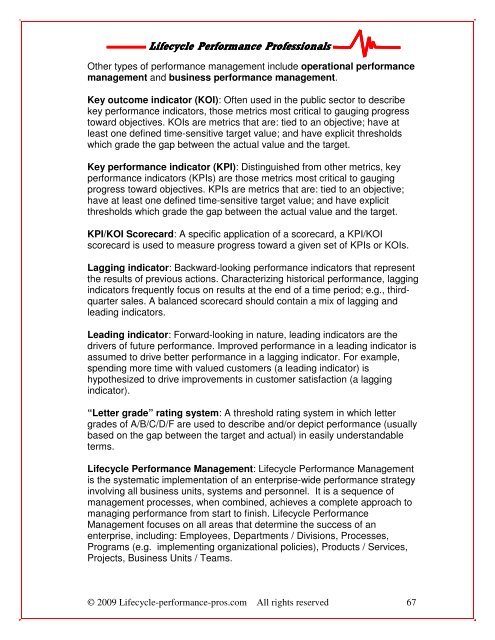Download the Performance Management Fundamentals Guide
Download the Performance Management Fundamentals Guide
Download the Performance Management Fundamentals Guide
You also want an ePaper? Increase the reach of your titles
YUMPU automatically turns print PDFs into web optimized ePapers that Google loves.
Lifecycle Lifecycle <strong>Performance</strong> <strong>Performance</strong> Professionals<br />
Professionals<br />
O<strong>the</strong>r types of performance management include operational performance<br />
management and business performance management.<br />
Key outcome indicator (KOI): Often used in <strong>the</strong> public sector to describe<br />
key performance indicators, those metrics most critical to gauging progress<br />
toward objectives. KOIs are metrics that are: tied to an objective; have at<br />
least one defined time-sensitive target value; and have explicit thresholds<br />
which grade <strong>the</strong> gap between <strong>the</strong> actual value and <strong>the</strong> target.<br />
Key performance indicator (KPI): Distinguished from o<strong>the</strong>r metrics, key<br />
performance indicators (KPIs) are those metrics most critical to gauging<br />
progress toward objectives. KPIs are metrics that are: tied to an objective;<br />
have at least one defined time-sensitive target value; and have explicit<br />
thresholds which grade <strong>the</strong> gap between <strong>the</strong> actual value and <strong>the</strong> target.<br />
KPI/KOI Scorecard: A specific application of a scorecard, a KPI/KOI<br />
scorecard is used to measure progress toward a given set of KPIs or KOIs.<br />
Lagging indicator: Backward-looking performance indicators that represent<br />
<strong>the</strong> results of previous actions. Characterizing historical performance, lagging<br />
indicators frequently focus on results at <strong>the</strong> end of a time period; e.g., thirdquarter<br />
sales. A balanced scorecard should contain a mix of lagging and<br />
leading indicators.<br />
Leading indicator: Forward-looking in nature, leading indicators are <strong>the</strong><br />
drivers of future performance. Improved performance in a leading indicator is<br />
assumed to drive better performance in a lagging indicator. For example,<br />
spending more time with valued customers (a leading indicator) is<br />
hypo<strong>the</strong>sized to drive improvements in customer satisfaction (a lagging<br />
indicator).<br />
“Letter grade” rating system: A threshold rating system in which letter<br />
grades of A/B/C/D/F are used to describe and/or depict performance (usually<br />
based on <strong>the</strong> gap between <strong>the</strong> target and actual) in easily understandable<br />
terms.<br />
Lifecycle <strong>Performance</strong> <strong>Management</strong>: Lifecycle <strong>Performance</strong> <strong>Management</strong><br />
is <strong>the</strong> systematic implementation of an enterprise-wide performance strategy<br />
involving all business units, systems and personnel. It is a sequence of<br />
management processes, when combined, achieves a complete approach to<br />
managing performance from start to finish. Lifecycle <strong>Performance</strong><br />
<strong>Management</strong> focuses on all areas that determine <strong>the</strong> success of an<br />
enterprise, including: Employees, Departments / Divisions, Processes,<br />
Programs (e.g. implementing organizational policies), Products / Services,<br />
Projects, Business Units / Teams.<br />
© 2009 Lifecycle-performance-pros.com All rights reserved 67










